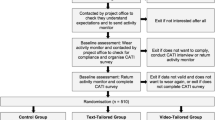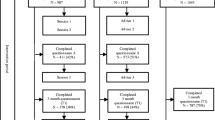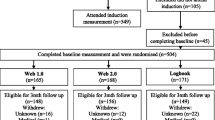Abstract
The Internet has the potential for delivering innovative, interactive physical activity (PA) interventions to large numbers of people. This study was designed to test the efficacy of an Internet intervention that consisted of a Web site plus 12 weekly e-mail tip sheets, compared with a waiting list control group. The Internet intervention was theory based and emphasized clear, graphical presentation of PA information. Sixty-five (30 intervention and 35 control) sedentary adult employees of several large hospitals (9 men and 56 women) were randomly assigned to 1 of the 2 study arms. Of the 65 participants, 57 completed the 1-month follow-up, and 52 completed the 3-month follow-up. At both 1 and 3 months, those in the intervention group were significantly more likely to have progressed in stage of motivational readiness for PA than participants in the control group: 1 month, χ2(1, N=52) = 4.05, p > .05; 3 months, χ2(1, N = 52) = 6.45, p > .01. We hypothesized that at 1 and 3 months, the intervention group would exhibit significant increases relative to the control group on the number of minutes of moderate activity. At the 1-month assessment, the intervention group did exhibit significant increases, relative to the control group in moderate minutes, F(1, 54) = 5.79, p > .05; however, at the 3-month assessment this difference was no longer significant. In addition, secondary analyses were conducted to examine total number of minutes of walking reported. At 1 month, the intervention group did exhibit significant increases, relative to the control group, in walking minutes, F(1, 54) = 12.1, p > .001. At the 3-month assessment, amount of time spent in walking activity continued to be significantly higher for the intervention group compared with the control group, F(1, 48) = 5.2, p > .05. These findings show that a theoretically based PA Web site and weekly e-mail tip sheets can have a short-term impact on PA motivation and behavior both at 1 and 3 months. As Internet access increases, and as bandwith and other technical attributes of this medium improve, Web site delivered health behavior interventions will become increasingly useful in public health promotion.
Similar content being viewed by others
References
Kujala UM, Kaprio J, Sarna S, Koskenvuo M: (1998), Relationship of leisure-time physical activity and mortality: The Finnish Twin Cohort.Journal of the American Medical Association. 1998,279:440–444.
Powell KE, Blair SN: The public health burdens of sedentary living habits: Theoretical but realistic estimates.Medicine and Science in Sports and Exercise. 1994,26:851–856.
Williams PT: Physical fitness and activity as separate heart disease risk factors: A meta-analysis.Medicine & Science in Sports & Exercise. 2001,33:754–761.
Hu FB, Stampfer MJ, Colditz GA, et al.: Physical activity and risk for stroke in women.Journal of the American Medical Association. 2000,283:2961–2967.
U.S. Department of Health and Human Services:Physical Activity and Health: A Report of the Surgeon General. Atlanta, GA: Centers for Disease Control and Prevention, National Center for Chronic Disease Prevention and Health Promotion, 1996.
Pate RR, Pratt M, Blair SN, et al.: Physical activity and public health: A recommendation from the Centers for Disease Control and Prevention and the American College of Sports Medicine.Journal of the American Medical Association. 1995,273:402–407.
Centers for Disease Control: Physical activity trends: United States, 1990-1998.Morbidity and Mortality Weekly Report. 2001,50:166–168.
Napolitano MA, Marcus BH: Breaking barriers to increased physical activity.The Physician and Sports Medicine.2000,28:88–89.
Sallis JF, Owen N:Physical Activity and Behavioral Medicine. Thousand Oaks, CA: Sage, 1999.
Marcus BH, B anspach SW, Lefebvre RC, et al.: Using the stage of change model to increase the adoption of physical activity among community participants.American Journal of Health Promotion. 1992,6:424–429.
Marcus BH, Emmons KM, Simkin-Silverman LR, et al.: Evaluation of motivationally tailored vs. standard self-help physical activity interventions at the workplace.American Journal of Health Promotion. 1998,12:246–253.
Owen N, Lee C, Naccarella L, Haag K: Exercise by mail: A mediated behavior-change program for aerobic exercise.Journal of Sport Psychology. 1987,9:346–357.
Gustafson DH, Robinson TN, Ansley D, et al.: Consumers and evaluation of interactive health communication applications.American Journal of Preventive Medicine. 1999,16:23–29.
Robinson TN, Patrick K, Eng, TR, Gustafson D: An evidenced-based approach to interactive health communication.Journal of the American Medical Association. 1998,280:1264–1269.
Fox S, Rainie L, Horrigan J, et al.: The online health care revolution: How the Web helps Americans take better care ofthemselves. Retrieved July 31, 2001 from http:// www.pewinternet.org
Rainie L, Packel D, Fox S, et al.:More online, doing more: 16 million newcomers gain Internet access in the last half of 2000 as women, minorities, and families with modest incomes continue to surge online. Retrieved July 31, 2001 from http://www.pewinternet.org
Fotheringham MJ, Bauman A, Leslie E, Owen N: Computer use—A barrier to physical activity? 22nd annual meeting of the Society of Behavior Medicine. Seattle, WA: 2001.
Fotheringham MF, Wonnacott RL, Owen N: Computer use and physical inactivity in young adults: Public health perils and potentials of new information technologies.Annals of Behavioral Medicine. 2000,22:269–275.
McKay HG, Feil EG, Glasgow RE, Brown JE: Feasibility and use of an Internet support service for diabetes self-management.The Diabetes Educator. 1998,24:174–179.
Kolasa K, Poehlman G, Jobe A: Virtual seminars for disseminating medical nutrition education curriculum ideas.American Journal of Clinical Nutrition, 71, 1403-1404.
Berlan GK, Elliott MN, Morales LS, et al.: Health information on the Internet: Accessibility, quality, and readability in English and Spanish.Journal of the American Medical Association. 2001,285:2612–2621.
Tate DF, Wing RR, Winett RA: Using Internet technology to deliver a behavioral weight loss program.Journal of the American Medical Association. 2001,285:1172–1177.
Whiteley JA,Winett RA, Anderson ES, Wojcik J:Internet-based cognitive behavioral walking program for women. Annual meeting of the association of the Advancement of Behavior Therapy. New Orleans, LA: 2000.
Marcus BH, Bock BC, Pinto BM, et al.: Efficacy of an individualized, motivationally-tailored physical activity intervention.Annals of Behavioral Medicine. 1998,20:174–180.
Fotheringham MF: PA Web: Evaluation of an Internet-based physical activity behavior change program. Annual meeting of the Society for Behavioral Medicine,Interactive Health Communication in Health Behavior Change Symposium. Seattle, WA: 2001.
Manson JE, Hu FB, Rich-Edwards JW, et al.: A prospective study of walking as compared with vigorous exercise in the prevention of coronary heart disease in women.New England Journal of Medicine. 1999,341:650–658.
Stofan JR, DiPietro L, Davis D, et al.: Physical activity patterns associated with cardiorespiratory fitness and reduced mortality: The aerobics center longitudinal study.American Journal of Public Health. 1998,88:1807–1813.
American College of Sports Medicine:ACSM’s Guidelines for Exercise Testing and Prescription (6th ed.). New York: Lippincott, Williams, & Wilkins, 2000.
Marcus BH, Rossi JS, Selby VC, et al.: The stages and processes of exercise adoption and maintenance in a worksite sample.Health Psychology. 1992,11:386–395.
Jones DA, Ainsworth BE, Macera CA, et al.: Reliability and validity of walking questions in the Behavioral Risk Factor Surveillance System (BRFSS).Medicine and Science in Sports and Exercise. 1999,31:S232.
Marcus BH, Selby VC, Niaura RS, Rossi JS: Self-efficacy and the stages of exercise behavior change.Research Quarterly for Exercise and Sport. 1992,63:60–66.
Sciamanna CN, Lewis B, Tate D, et al.: User attitudes toward a physical activity promotion Website. Manuscript submitted for publication.
Blair SN, Haskell WL, Ho P, et al.: Assessment of habitual physical activity by seven-day recall in a community survey and controlled experiments.American Journal of Epidemiology. 1985,122:794–804.
Marcus BH, Nigg CR, Riebe D, Forsyth LH: Interactive communication strategies: Implications for population-based physical activity promotion.American Journal of Preventive Medicine. 2000,19:121–126.
Dunn AL, Andersen RE, Jakicic JM: Lifestyle physical activity interventions: History, short- and long-term effects and recommendations.American Journal of Preventive Medicine. 1998,15:398–412.
Author information
Authors and Affiliations
Corresponding author
Additional information
This research was supported in part by Grant HL64342. We thank Beth Lewis, Ph.D. for her helpful comments on this manuscript and Mary Roberts, M.S. for her contributions to the data analysis.
About this article
Cite this article
Napolitano, M.A., Fotheringham, M., Tate, D. et al. Evaluation of an internet-based physical activity intervention: A preliminary investigation. ann. behav. med. 25, 92–99 (2003). https://doi.org/10.1207/S15324796ABM2502_04
Published:
Issue Date:
DOI: https://doi.org/10.1207/S15324796ABM2502_04




